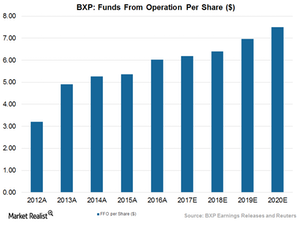Why Boston Properties Could Be Strong Enough to Combat Headwinds
Boston Properties’ recent upbeat results came on the back of higher leasing activity as well as strong occupancy levels, which led to revenue growth.
Sept. 1 2017, Updated 11:02 a.m. ET

The REIT sector as a whole is poised to grow in 2017
The recent pro-American rhetoric from Donald Trump has helped the US economy to finally set itself on a growth trajectory. We have seen slow but steady growth and also a significant rise in the GDP level.
This macro environment has led to a sense of optimism among US consumers, which has made them increase their discretionary spending, thus raising demand. The environment has triggered growth for the REITs (real estate investment trusts) as well.
The commercial REITs in particular like Boston Properties (BXP), Simon Property (SPG), Prologis (PLD), and Vornado Realty Trust (VNO) are leaving no stones unturned in order to tap the opportunities that lie ahead for them in the growing economy. These REITs form approximately 15% of the First Trust S&P REIT ETF (FRI). The ETF has almost 99% exposure to the ETF.
Apart from undertaking many development and expansion activities in order to maintain profitability and leadership in the industry, they are also positioning their properties in strategic locations to attract tenants.
Let’s study Boston Properties (BXP), one such commercial REIT, to find out how the company has been performing and whether it will add value to investors.
What lies ahead for BXP?
Boston Properties, which specializes in developing and renting office properties, is based in Boston, Massachusetts. As of June 30, 2017, BXP owned 175 real estate properties spanning an area of 48.4 million square feet. Out of these properties, nine properties were under construction or being redeveloped. The company’s properties mostly consisted of Class A office properties.
Boston Properties has showcased strong business momentum in the past few quarters. For 1Q16, Boston Properties has surpassed Wall Street FFO (funds from operations) estimates in four of the six trailing quarters. It marginally missed estimates by ~1% in 3Q16 and 1Q17 each. The company has also reported year-over-year growth in its profit.
The upbeat results came on the back of higher leasing activities as well as strong occupancy levels, which led to revenue growth. The company’s tight cost control initiatives also helped it to maintain decent profit levels and also post year-over-year growth.
In the next article, we’ll look into the results of the company in the recently concluded 2Q17.
